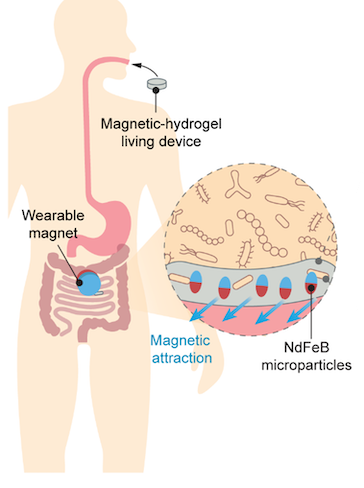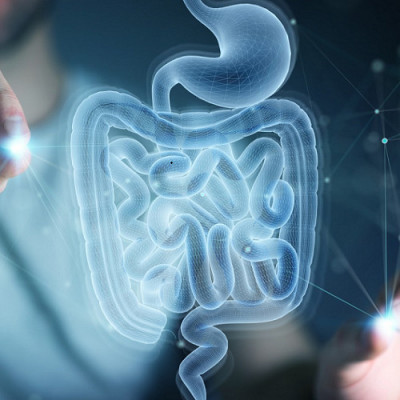“The challenge is that the gut is like a black box. We still don’t fully understand it because it’s difficult to access and study,” says Maria Eugenia Inda, a Pew Postdoctoral Fellow at MIT’s Department of Electrical Engineering and Computer Science (EECS).
Inda and colleagues report a new approach to solve that problem in the journal Advanced Functional Materials. Their work involves encapsulating living bacteria in a tiny, flexible disc of hydrogel that is ingested. Those bacteria, in turn, can detect compounds that could indicate disease. After eventual excretion of the disc, the bacteria within the disc can be analyzed to determine what they’ve detected and in what concentrations.
To keep these living sensors in the gut long enough to do their work, rather than being naturally excreted within six to 48 hours, the team made the disc magnetic. Combined with a small wearable magnet, this keeps the system in place internally for several days. Take off the magnet, and the sensor with its data is excreted and ready for analysis.
“This exciting technology offers a much-needed tool to help control and understand imbalances of chemicals produced in the gastrointestinal tract,” says Giovanni Traverso, the Karl Van Tassel (1925) Career Development Professor in MIT’s Department of Engineering. Traverso was not involved in the research.
Senior authors of the Advanced Functional Materials paper are Timothy Lu, an MIT associate professor of EECS and biological engineering, and Xuanhe Zhao, an MIT professor of mechanical engineering and of civil and environmental engineering. Lu is also affiliated with MIT’s Materials Research Laboratory.
“We developed new soft materials such as the magnetic hydrogels and studied their extreme mechanics such as deformation and adhesion in the gut. In collaboration with the Lu lab, we explored soft materials’ impacts on living materials and biomedicine,” says Zhao.
Along with Zhao, Lu, and Inda, other authors are Graduate Student Xinyue Liu, Visiting Student Yueying Yang, Graduate Student Shaoting Lin, Postdoctoral Fellow Jingjing Wu, Graduate Student Yoonho Kim, Postdoctoral Associate Xiaoyu Chen, and Postdoctoral Associate Dacheng Ma. Ma and Inda are in the Lu lab; the others are affiliated with the Zhao lab. Inda, Liu, and Yang contributed equally to the work.
Many Challenges
The Advanced Functional Materials paper reports important advances toward making the hydrogel-bacteria system in the gut a reality. For example, the researchers describe the best “recipe” for the hydrogel disc that allows it to not only provide a home for the bacterial sensors—and allow them to reproduce—but also survive the movements and pressures associated with the intestinal system without breaking up or becoming dislodged.
The team showed that the bacteria could indeed survive and thrive in the hydrogel disc for up to seven days. In mice, the bacteria successfully sensed bleeding in the gut. Further, in a model of the human gut the scientists showed that the wearable magnet kept the disc in place at several different locations, including the small intestine and the ascending colon.
The bacteria used in the system were genetically engineered by the Lu lab to detect factors associated with bleeding. The Lu lab is working on a variety of other genetically engineered bacteria capable of not only detecting multiple chemicals, but also releasing therapeutics when a problem is encountered.
In addition to the bacterial sensors, the team also incorporated into the hydrogel a tiny electronic temperature sensor. That, too, worked, showing the potential for integrating both microelectronics and living sensors into the hydrogel system.
Inda emphasizes the collaborative nature of the work. The hydrogel experts such as Xinyue Liu, for example, aimed to make the gel matrix tough enough to survive inside the gut. The biologists, such as Inda, focused on keeping the bacteria alive within the hydrogel disc. Together they developed a system that achieved both goals.
Toward the Future
Inda notes that while it may take a while for the system to be used in humans, “it could be used today in laboratory mice.”

Schematic illustrating the use of living sensors encapsulated in a magnetic hydrogel device for studies of the gut.
Rabia Yazicigil is an assistant professor in the Department of Electrical and Computer Engineering at Boston University. Says Yazicigil, who was not involved in the research, "By localizing diagnostic bacteria in specific regions of the gut, biological hypotheses and treatments can be conveniently tested in animal models, for example, through dietary change, therapeutics, or genetic alteration of host or microbes."
And those tests, in turn, should result in new insights with applications to humans.
This work was supported by MIT, the National Science Foundation, the Defense Threat Reduction Agency, the Leona M. and Harry B. Helmsley Charitable Trust, the National Institutes of Health, Pfizer Inc., the US Army Medical Research and Material Command, the Space and Naval Warfare Systems Center, the Defense Advanced Research Projects Agency, the Army Research Office, the American Heart Association, the Human Frontier Science Program, the Singapore-MIT Alliance for Research and Technology, the Breast Cancer Alliance, the United States-Israel Binational Science Foundation, the Amyotrophic Lateral Sclerosis Association, the MIT Science and Technology Initiatives, and the Pew Charitable Trusts.
Read the original article on MIT Materials Research Laboratory.
